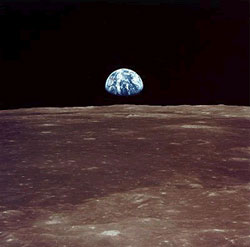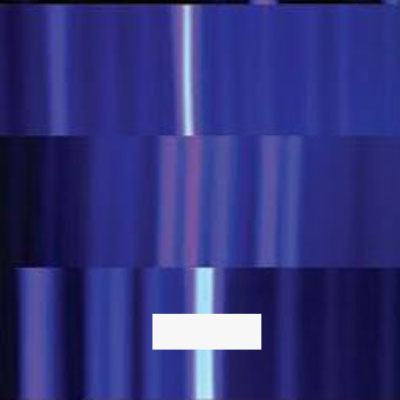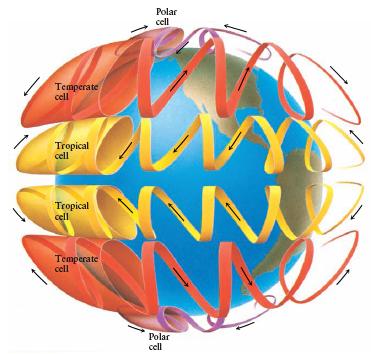
Chapter 9. The Earth's Energy Sources
9.1 Introduction

Author: Jordan Raddick, Johns Hopkins University
Editor: Beth Hufnagel, Anne Arundel Community College
The goals of this module: At the end, you should be able to:
- Identify three of the five sources of energy that drive motion and change in the Earth.
- Explain how solar energy and the rotation of the Earth work together to create the motions of the Earth's atmosphere.
- Explain how solar energy drives ocean currents.
In this module you will explore:
- Three of the five energy sources for changes in the Earth: solar energy, Earth's rotation, and tidal forces. (The other two are heat of formation and radioactive decay.)
- Ways that this energy works to create motion and change in the Earth's atmosphere and oceans.
Why you are doing it: By understanding the Earth's energy sources and how this energy is transferred, you can better understand the processes that cause motions and changes in the Earth.
9.2 Background

The Earth is our home planet. Nearly all of the events of human history, all the vast changes that we have experienced, have taken place here on the surface of the Earth. But the Earth itself is constantly changing too. Earth is a complex system that includes land, water, and air, and all of these parts interact with each other to create motion and change. All these motions and changes require energy to continue.
Different energy sources act on different parts of the Earth. In this activity, you'll explore how different energy sources drive different motions.
Let's start with the atmosphere.
9.3 Solar Energy Heats the Atmosphere
In the animation below, on the right, you see a pot of water heating on a stove. Turn on the stove and watch what happens!
You have probably seen something like it yourself. The circular motion of the water in a heating pot is called convection. It turns out that the motion of air in the Earth's atmosphere can also be explained by convection.
On the left, you see the Earth's surface and its atmosphere. "Light" the sun and watch what happens!
Question Sequence
Question 1.
Which best describes the path that the water follows in the boiling pot?
The boiling water
| A. |
| B. |
| C. |
| D. |
Question 2.
Which best describes the path that air heated by the Sun follows?
| A. |
| B. |
| C. |
| D. |
Summary
But you may have noticed that the animation of the Earth above isn't quite realistic - this Earth doesn't rotate, while our real Earth does! The animation shows what would happen if the Earth didn't rotate, but the Earth's rotation does have some effect on how the atmosphere moves. Continue to find out how.
9.4 Earth's Rotation Affects the Motion of the Atmosphere
The animation below is a more realistic diagram of the Earth, with the Earth's rotation included. Click the Sun to heat up this Earth, and watch what happens.

Question Sequence
Question 3.
How are the motions of air on the real Earth similar to air motions on the imaginary non-rotating Earth? In the real, rotating Earth air
| A. |
| B. |
| C. |
| D. |
| E. |
Question 4.

In the 16th century, Spanish sailors realized that they could sail quickly from Spain to its Central American colonies. This is because the winds were pushing them in the direction they wanted to go. True or False?
| A. |
| B. |
9.5 Solar Energy Moves the Oceans
The atmosphere is not the only thing in constant motion on Earth - the oceans move too. The energy that drives this motion also comes from the Sun. Study the animation below to see how the oceans move.

Question Sequence
Question 5.
Where do the warm currents start?
| A. |
| B. |
| C. |
| D. |
Question 6.
Why does the ocean warm up at the place where the warm currents start?
| A. |
| B. |
| C. |
Question 7.
The warm currents become cold currents near the poles because
| A. |
| B. |
| C. |
9.6 Review Activity
Now, review your knowledge. Look at the following diagram, which shows different types of motion on the Earth. Label the diagram with the energy sources that drive each type of motion by dragging and dropping the provided labels. Some motions will require two labels, some only one. You will use some of the labels more than once.

9.7 Quick Check Quiz
Indepth Activity: The Earth's Energy Sources
Question 8.
The energy arriving from the Sun is:
| A. |
| B. |
| C. |
| D. |
| E. |
Question 9.
The tides cause ocean water to:
| A. |
| B. |
| C. |
| D. |
| E. |
Question 10.
Cold ocean currents start:
| A. |
| B. |
| C. |
| D. |
| E. |
Question 11.
Cold ocean currents:
| A. |
| B. |
| C. |
| D. |
| E. |
Question 12.
The rotation of the Earth:
| A. |
| B. |
| C. |
| D. |
| E. |
Question 13.
Water in a heating pot rises
| A. |
| B. |
| C. |
Question 14.
Air in the atmosphere moves because heat energy from the Sun changes the air's
| A. |
| B. |
| C. |
| D. |
Question 15.
Air in the atmosphere moves vertically because of energy from the Sun, and it moves horizontally because of energy from
| A. |
| B. |
| C. |
| D. |
Question 16.
If the Earth did not rotate, air in the atmosphere would move
| A. |
| B. |
| C. |
| D. |
Question 17.
How are cold and warm ocean currents connected?
| A. |
| B. |
| C. |
| D. |
Activity results are being submitted...